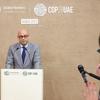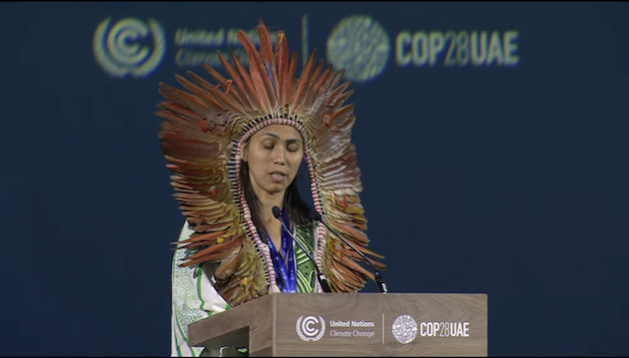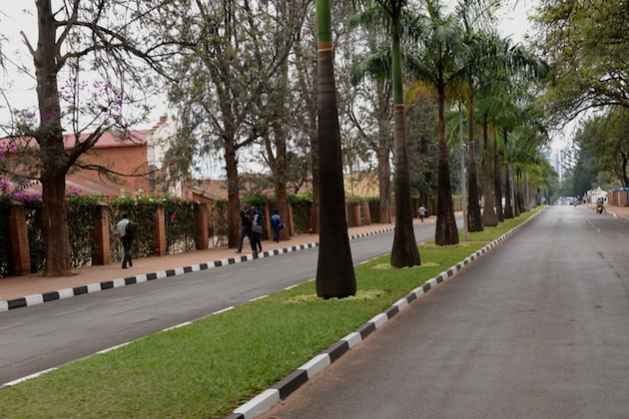
Creator and Web page info
- This web page: https://www.globalissues.org/article/805/cop20-lima-climate-conference.
- To print all info (e.g. expanded facet notes, reveals different hyperlinks), use the print model:
On this web page:
Introduction
 December 1 – 14, 2014, Lima, Peru was the venue for the twentieth annual United Nations Local weather Change Convention, also referred to as the twentieth Convention of the Events — or COP 20.
December 1 – 14, 2014, Lima, Peru was the venue for the twentieth annual United Nations Local weather Change Convention, also referred to as the twentieth Convention of the Events — or COP 20.
The aim of this convention was to create a common settlement on local weather change motion and start the method of financing mitigation.
Assembly end result
The assembly ended with all nations agreeing to chop again greenhouse gasoline emissions. Often called the Lima Accord, this treaty is just not legally binding and international locations wouldn’t have to specify how a lot they are going to reduce, as an alternative agreeing to report their plans again by March 2015.
Whereas for a lot of it seemed like a profitable end result, others have been upset, equivalent to poor international locations struggling to rebuild from present impacts of local weather change who have been alarmed on the disappearance of loss and injury commitments from the ultimate textual content which has been a part of the dialogue for years.
The worldwide local weather motion, 350.org, summarized the disappointments and hopeful features of the assembly end result, noting
- The brand new settlement doesn’t mirror the urgency of the local weather disaster
- Some good agreements – however no measures to make sure implementation
- Least developed and susceptible nations unnoticed within the chilly
- Divestment (from fossil gas reliance) is extra necessary than ever
- World momentum for actual options is stronger than ever and can carry on going.
In making an attempt to place a constructive spin on the general disappointment they felt, they concluded, In the long run, a world local weather treaty is only one software to fight local weather change. Actual change goes to proceed to return from the grassroots. The UN Local weather Talks proceed to be a spot the place the world’s international locations comes collectively to debate this disaster and persons are placing in monumental efforts to ensure Paris (the subsequent international assembly) gained’t be like Copenhagen
which was stuffed with disappointments regardless of huge guarantees.
Samantha Smith, Chief of WWF’s World Local weather and Vitality Initiative, was fairly scathing of the assembly end result saying that political expediency gained over scientific urgency
. She additionally famous that Developed nation governments couldn’t even handle to clarify how they are going to ship the long-promised US$100 billion per yr in local weather finance by 2020. In a transfer that seemingly dismissed the plight of essentially the most susceptible international locations, they utterly eliminated any significant language about ‘loss and injury’.
Mainstream media reporting
As with nearly each earlier assembly (with occasional exceptions), mainstream media reporting was very poor given the significance of this international challenge. The place the assembly was reported it was typically in the direction of the tip, and simply sound chunk sort summaries saying all international locations agreed to emission cuts and that this was a serious enchancment.
Whereas the treaty continued to say it honors the long-standing widespread however differentiated tasks
the mainstream media reporting (as in most years) has usually failed to supply rationalization and context of this precept that has been an necessary a part of these talks for over 2 many years; that poor and growing international locations shouldn’t bear the identical tasks because the developed ones (as a result of they aren’t the reason for the anthropogenic carbon emissions over the earlier many years which have led to this, which is detailed way more on this website’s web page on local weather justice).
A touch in the direction of this precept could have been offered as a viewpoint of China or India, given the impression they’re being obstacles, moderately then explaining this precept in additional context.
That was simply one of many points skirted over or omitted from widespread reporting. Others included points on financing, know-how assist for poorer nations, and so forth. Behind the scenes, for many years, wealthy international locations have stalled on these items or actively averted making an attempt to share know-how and so forth, which is barely reported.
Yearly, this criticism is fabricated from mainstream reporting, so with out following these negotiations every year, it may be simple to return away with the impression that this assembly had a constructive end result.
However as this dialogue hosted by Democracy Now! reveals, there have been quite a lot of necessary problems with competition:
In context: widespread however differentiated tasks
A few years in the past all nations agreed that local weather change was largely the results of actions from as we speak’s industrialized nations, as carbon dioxide — the principle greenhouse gasoline — stays within the environment for many years. But, the poorest would find yourself struggling essentially the most for an issue they largely didn’t trigger. The approaches to mitigation (emissions discount) would due to this fact be totally different for these teams of nations — the widespread however differentiated tasks precept.
It’s on this context that the dialogue for loss and injury has come about. And it’s one thing that wealthy international locations are eager to do away with .
The years of resistance on this challenge (and lots of others) means every time it’s mentioned once more the reactions appear to get much more hostile. Mixed with the shortage of detailed context within the mainstream media protection of this facet, it then turns into simpler every time to see culprits as China and India given their monumental greenhouse emissions in recent times, in comparison with the far larger quantity by the industrialized nations over the longer interval. See this website’s part on local weather justice for extra detailed background.
And as this website has stated for years on the local weather justice web page, the wealthy nations are delaying any significant motion till it’s finally — and disproportionately — paid for the by the growing nations. New Delhi based mostly Nitin Sethi, affiliate editor at Enterprise Customary, interviewed within the earlier talked about video says the identical factor, however extra frankly:
There isn’t any motion that’s going to occur between now and 2020. All of that was to be accomplished by the developed international locations. They (wealthy nations) principally have simply stated at Lima that
we’re not going to do any greater than what we’re doing thus far, and the burden can shift onto the post-2020 period, the place different growing international locations need to share it.So, to me, it signifies actually negotiation in unhealthy religion.
Extra info
Because the convention remains to be underway as this web page is written, extra info will likely be added right here after the occasion is over.
For extra in regards to the points from different organizations, listed here are some beginning factors:
Information tales from IPS
Beneath is a listing of tales from Inter Press Service associated to the Lima local weather convention and its aftermath.
-
For Africans, the Local weather Debate Across the Position of Livestock Misses the Mark
– Inter Press Service

NAIROBI, Kenya, Dec 08 (IPS) – Africa is contending with a local weather disaster it didn’t create with out ample recognition for the distinctive rights and desires of the world’s youngest and fastest-growing inhabitants. Not solely is the continent least answerable for decreasing greenhouse gasoline emissions, having traditionally produced only a tiny fractionhowever additionally it is disproportionately impacted by the results of emissions generated elsewhere.
-
Why Local weather Justice and World Monetary Reform Are Inseparable
– Inter Press Service

DUBAI & DOMINICA, Dec 08 (IPS) – An award-winning worldwide improvement skilled and a local weather justice skilled have known as for a rethink of the worldwide monetary system that will convey reparatory justice to small, climate-vulnerable nations whereas providing concessionary improvement financing to the international locations most in want of help.
-
Our voices and desires have to be put first in local weather talks, younger individuals inform COP28
– UN Information

Younger local weather advocates at COP28 in Dubai on Friday stated they won’t sit idly by whereas local weather change threatens their futures. They demanded that authorities policymakers put the wants of the world’s practically 2 billion youngsters first – their voices and concepts can assist rescue the planet.
-
Religion Pavilion Provides Religious Dimension to Local weather Disaster Decision
– Inter Press Service

DUBAI, Dec 07 (IPS) – For the primary time at COP28, religion has a pavilion alongside science, know-how, nations, and philanthropy, permitting spiritual leaders from everywhere in the world to debate the potential for utilizing non secular deserves to guard the earth from local weather change.
-
COP28: Local weather Migrants Rights, Danger-based Labor Polices Underneath the Highlight
– Inter Press Service

DUBAI, Dec 07 (IPS) – With COP23 underway, researchers and activists are pointing on the plight of local weather migrants.
-
COP28 is about motion, not politics and level scoring, says UN local weather chief
– UN Information

UN local weather chief Simon Stiell stated on Wednesday that COP28 delegates aren’t in Dubai to “rating factors” and play at “lowest-denominator politics”; they have to take bold motion on curbing international warming and ending the local weather disaster.
-
Rising Local weather Finance Infrastructure to Match Africa’s Inexperienced Bankable Options
– Inter Press Service

DUBAI, Dec 06 (IPS) – Though lengthy profiled because the face of local weather change, a high-risk continent with a pipeline of unbankable inexperienced initiatives, there are areas the place Africa is main the world. The 1987 unintentional discovery of the primary deposit of pure hydrogen throughout a water drilling marketing campaign in Bourakebougou village, Mali, is as we speak proving that Africa can export viable inexperienced options.
-
The Local weather Disaster is an Schooling Disaster
– Inter Press Service

London/New York, Dec 05 (IPS) – “The one worldwide language the world understands” wrote Eglantyne Jebb, founding father of Save the Youngsters, “is the cry of a kid,” and the proof is accumulating that youngsters aren’t solely the harmless victims of battle whose pleas should be heard, but in addition essentially the most susceptible victims of local weather change.
-
Why the UN COP28 Local weather Talks Should Serve Farmers to Obtain a Simply Transition
– Inter Press Service

DUBAI, Dec 05 (IPS) – Meals and agriculture is a prime agenda merchandise at UNFCCC COP28because the world considers the best way to deal with the local weather impacts of what we eat and the way we produce it. The stage has been set for COP28 to be a “meals COP”, however for commitments to translate to motion, it should even be a “farmers’ COP”.
-
Ten African Nations to Profit From USD 100 Million Launched by Inexperienced Local weather Fund
– Inter Press Service

DUBAI, Dec 05 (IPS) – The Inexperienced Local weather Fund (GCF) has introduced the discharge of USD 100 million on the ongoing United Nations Framework Conference on Local weather Change (UNFCCC) twenty eighth Convention of Events (COP 28) in Dubai, UAE, to assist 10 African international locations in adapting meals loss discount options.
-
COP28: Tuesday’s local weather motion in Dubai
– UN Information

The UN local weather convention will proceed its work on Tuesday specializing in points that embody scaling up financing for the Paris Settlement, slashing emissions within the cooling sector, guaranteeing a local weather resilient vitality sector and a dialogue with indigenous peoples.
-
A Local weather Scientist’s View of COP 28
– Inter Press Service

STOCKHOLM, Sweden, Dec 04 (IPS) – This yr’s UN Local weather Change Convention is happening in Dubai from 30 November to 12 December. The so-called COP summits are organised yearly and represent a method for the worldwide group to agree on methods to handle the local weather disaster, equivalent to limiting international temperature rise to 1.5 levels Celsius, supporting susceptible communities to adapt to the results of local weather change, and reaching net-zero emissions by 2050.
-
COP28: Carry the susceptible to ‘entrance of the road’ for local weather funding
– UN Information

Advocates showcased the devastating impacts of local weather upheaval on their communities at COP 28 on Monday as the main target of the world’s largest local weather gathering turned to monetary assist for these most in danger – firstly youth and ladies in growing international locations.
-
COP28: Ladies and local weather advocates driving ahead change collectively
– UN Information

To fight the disproportionate impacts of local weather change on ladies, advocates at COP28 on Monday stated decisionmakers should not solely enact extra polices that meet their particular wants however acknowledge the distinctive data and experience ladies can supply that can be utilized to assist efficient local weather motion.
-
COP28: Methane pledge by the ‘giants behind the local weather disaster’ falls brief, says Guterres
– UN Information

UN Secretary-Basic António Guterres on Sunday despatched a powerful message to the oil and gasoline trade: the pledges made at COP28 in Dubai fall properly in need of what’s wanted to meaningfully deal with the local weather disaster.
-
COP28: The local weather disaster can also be a well being disaster
– UN Information

Well being has made it onto the agenda of a UN local weather convention, and well being advocates at COP28 in Dubai on Sunday stated the subject was lengthy overdue for dialogue as local weather inaction is costing lives and impacting well being each single day.
-
Why is There Funding for Struggle However By no means for Local weather finance, Ask Feminists
– Inter Press Service

DUBAI, Dec 02 (IPS) – The Feminist Inexperienced New Deal Coalition has highlighted feminist local weather options and shared feminist insurance policies and frameworks which can be advancing simply local weather insurance policies on the United Nations Framework Conference on Local weather Change (UNFCCC) twenty seventh session of the Convention of Events (COP28) in Dubai.
-
Tackling well being impacts of local weather change and scaling up digital local weather motion within the highlight at COP28
– UN Information

Delegates at COP28 in Dubai on Saturday known as for stronger and extra resilient international well being methods, that are indispensable to defending populations from the unfavourable impacts of local weather change on well being.
-
Local weather Change Not Simply One other Subject in Your Inbox, Leaders advised
– Inter Press Service

DUBAI, Dec 1 2023 (IPS) – United Nations Secretary-Basic António Guterres stated world leaders wanted to urgently commit to 3 methods: lower emissions, speed up a simply, equitable transition to renewables, and to local weather justice.
-
Restoring Indigenous Bushes: New Mission to Fight Local weather Change in Rwanda
– Inter Press Service

KIGALI, Dec 01 (IPS) – With the continuing nationwide tree-planting marketing campaign, Rwanda seeks to exchange its degraded forest ensuing from charcoal manufacturing and firewood and improve the necessity for development supplies with new indigenous bushes to fight local weather change.
-
World agrifood methods are the local weather answer, new FAO report highlights
– UN Information

Agrifood methods and the communities that assist and depend upon them are on the entrance traces of loss and injury linked to local weather change, a brand new report launched on Friday by the UN Meals and Agriculture Group (FAO) has revealed.
-
Science factors to ‘local weather collapse’ as UN chief calls COP28 to motion
– UN Information

The world is heating up at an unprecedented tempo, new local weather knowledge reveals, and leaders gathered for the COP28 convention which opened in Dubai on Thursday should get us out of “deep hassle”, UN chief António Guterres stated.
-
Local weather change dangers upending international battle towards malaria
– UN Information

Local weather change and its impacts, significantly excessive climate and heatwaves, pose a “substantial threat” to progress being made to battle malaria, the UN World Well being Group (WHO) stated on Thursday.
-
Salvadoran Rural Communities Face Local weather Injustice
– Inter Press Service

TECOLUCA, El Salvador, Nov 30 (IPS) – For farmers within the valleys under the 15 de Septiembre hydroelectric plant in central El Salvador, the rains convey floods. Now that the rains are extra unpredictable, the lack of crops and disruption of fishing are much more devastating as they cope with erratic climate-change-induced flooding.
For many years, poor fishing and farming communities in southern El Salvador have paid the value for the electrical energy generated by one of many nation’s 5 dams, as fixed and typically excessive rains trigger the reservoir to launch water that finally ends up flooding the low-lying space the place the households dwell.
-
Oceans: Our First Line of Protection In opposition to the Impacts of Local weather Change
– Inter Press Service

MONTEREY BAY, California, Nov 29 (IPS) – Just some weeks in the past, UN Secretary Basic Antonio Guterres opened the Local weather Ambition Summit with a warning that by failing to behave on the local weather disaster, he stated “humanity has opened the gates of hell.” Couldn’t say it extra strongly. And he additionally stated, as you could recall, we’re transferring “towards a harmful and unstable world.”
-
Proper Right here, Proper Now: ECWs USD 150 Million Local weather Attraction to Save Youngsters at Danger
– Inter Press Service

NAIROBI, Nov 28 (IPS) – A catastrophic surge within the frequency, depth, and severity of maximum climate occasions has positioned youngsters on the frontlines of local weather emergencies. Practically half of the world’s youngsters, or one billion, dwell in international locations at extraordinarily excessive threat from the results of the local weather disaster. Most of those youngsters face a number of vulnerabilities.
-
U.S.-China Local weather Settlement: A Leap Ahead in World Local weather Cooperation
– Inter Press Service

CAIRO, Nov 27 (IPS) – The current U.S.-China summit on November 15 in San Francisco, towards a backdrop of low expectations, surprisingly made vital strides with the revealing of the “Sunnylands Assertion on Enhancing Cooperation to Handle the Local weather Disaster.” This settlement, the results of two years of negotiations between local weather envoys John Kerry and Xie Zhenhua, represents a substantial development following the 2021 joint declaration on the Glasgow Local weather Summit.
-
Can COP 28 Ship for Cities and Local weather Migrants?
– Inter Press Service

OXFORD, England, Nov 24 (IPS) – The impacts of local weather change on human mobility have but to be absolutely understood and addressed on a world scale, regardless that some 3.3 to three.6 billion persons are extremely susceptible to local weather change.
-
Africa Will Not Address Local weather Change With out a Simply, Inclusive Vitality Transition
– Inter Press Service

NAIROBI, Nov 24 (IPS) – A simply transition must be seen as a chance to rectify a number of the wrongs the place ladies aren’t prioritised within the vitality combine, but their expertise of the impression of local weather change is very large, says Thandile Chinyavanhu, a younger South African-based local weather and vitality campaigner with Greenpeace Africa.
-
In go to to Antarctica, Guterres appeals for motion to finish ‘local weather anarchy’
– UN Information

Antarctica has been known as the sleeping big, however it’s now being awoken by local weather chaos, the UN Secretary-Basic has warned.
Creator and Web page Info
- Created: